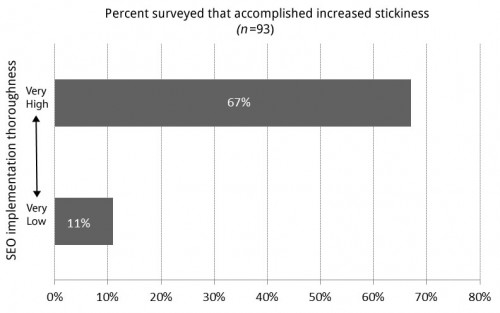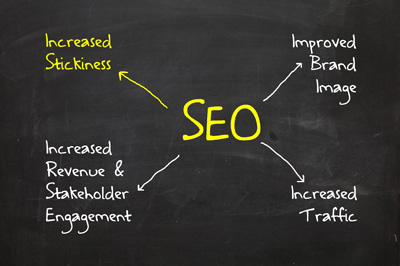Many Web properties are looking for ways to increase brand value, ecommerce success, or both. This has led to an interest in what is known as “customer stickiness.” On the Web, customer stickiness is the tendency for site users to visit a particular site frequently, spend more time on a site’s pages, and re-browse pages. Stickiness as defined here includes contains two elements:
- Session stickiness: the tendency to spend more time on a site in each site visit;
- Site stickiness: the tendency to spend more total time on a site spread over multiple sessions.
Why is customer stickiness important? A study of over 10,000 households found that purchases on e-commerce sites increased as stickiness increased [1]. This suggests that it is in the financial interest of transactional sites to increase their stickiness. And it’s reasonable to infer that brand marketers will see increases in brand awareness and engagement with an increase in stickiness.
It’s likely that many elements of good Web design will increase site stickiness. The following spring to mind without much effort: increased aesthetic appeal, enhanced usability, improved site performance, engaging content, etc. While Search Engine Optimization (SEO) isn’t the first thing I’d think of investing effort in if I’d wanted to improve site stickiness, in a recent study I led for Info-Tech Research Group entitled Drive Web Traffic with SEO [2], respondents reported that SEO did exactly that.
We surveyed IT and marketing leaders in over 90 organizations that redesigned their Web sites. We asked them how thorough they were about their SEO efforts and whether their redesigned site was stickier than the original site. Of those that reported very thorough SEO implementation, 67% said the redesigned site was stickier, compared to only 11% that rated their SEO efforts as very low. So very through SEO is six times more likely to be associated with increased stickiness when compared with not very through SEO, suggesting that if stickiness is the goal, SEO is worth the effort.

Fig 1. Get sticky with thorough SEO.
It’s pretty easy to understand how SEO can increase site traffic. Your site is seen by more searchers looking for what you are offering, some of whom click on a link in the search engine results page (SERP), more searchers come to your site, and so you end up with more traffic. The relationship is pretty direct.
But understanding how SEO can improve stickiness is not as straightforward. Here is my take:
- Keyword research provides content developers with an understanding of what is of interest to their users and how those ideas are expressed in specific words.
- Keyword rich content is by definition more interesting to users because it is focused on what they are searching for and expressed in their own language.
- This targeted content is sticker because it’s targeted. It might not be stickier for all potential users, but it’s sticker for users that arrive at site from a SERP, because it has content that is of interest to them.
There are other influencing aspects, but these factors are part of the reason why SEO has an impact on stickiness.
With Web site stickiness being associated with an increase in revenue, and thorough SEO being associated with a six-fold increase stickiness, implementing SEO seems like a no-brainer. Not only that, but the same Info-Tech study [2] found many other benefits which l have covered in posts on SEO and increased traffic, improved brand image, and increased revenue and stakeholder engagement.
In addition to these direct benefits, SEO has certain indirect benefits. For example, most of what needs to be done for SEO also makes site content more appealing and increases the number of links back to the site. This combination of direct and indirect benefits makes the case for SEO even stronger, leading to an easy decision: just optimize it!
- Is Stickiness Profitable for Electronic Retailers, Lin Lin et al, Communications of the ACM, March 2010
- Drive Web Traffic with Search Engine Optimization, InfoTech Research Group, April 2010
